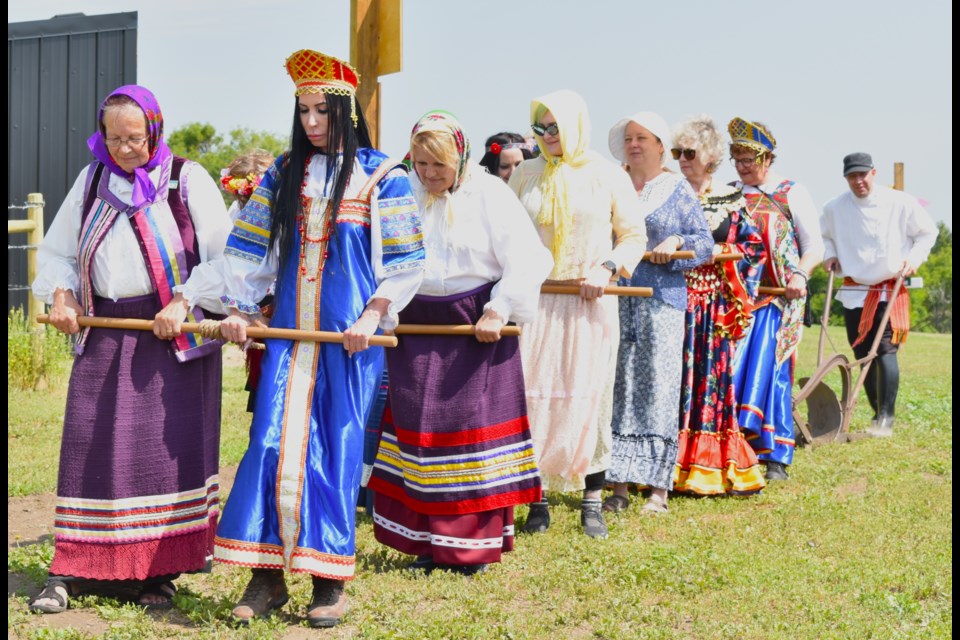BLAINE LAKE — The Doukhobor Dugout House has unveiled its summer opening, warmly welcoming visitors on Saturday, July 1. The house aims to educate guests about the culture and historical significance of the Russian Christians who made the prairies their home.
Those who participated in the 2023 Season of Colours celebrations on Canada Day were treated to melodious songs, captivating dances, and a concise account of the lives of the initial wave of Doukhobors who settled in Saskatchewan.
The festivities commenced with a re-enactment of the Doukhobor women's plow-pulling, as they tilled the soil and planted crops like potatoes while the men toiled to earn money to construct the Canadian railway in 1899.
The Doukhobors, a Christian sect in Russia renowned for their pacifism and divergence from non-Orthodox doctrines, constituted a religious minority in a predominantly Orthodox Russian society.
Due to Tsar Nicholas I's decree enforcing the compulsory assimilation of Doukhobor men into military conscription, which contradicted their pacifist principles, they were compelled to depart from their homeland. Simultaneously, women and children were required to resettle in the newly acquired territories of the empire.
One of the stories that were told was how Harv Kasakoff’s great-grandmother left Russia with her grandfather and their siblings. However, his great-grandfather, who had assumed a position in the Russian military, opposed her plan.
"When the time came for the Doukhobors to depart from Russia, my great-grandmother decided we should go to Canada. But my great-grandfather, who was working in the military, had a good job and decided not to leave," Kasakoff told SASKTODAY.
"He told my great-grandmother she could go, but the children must stay behind. It was a challenging period for the Doukhobors back then. So, they hid the children in wooden barrels and instructed them to remain quiet."
Kasakoff further shared that his great-grandfather, accompanied by other members of the Russian military, boarded the ship before its departure, searching for the concealed children. However, they still need to discover their hiding place. The children were taken out from the barrels only when the ship sailed hundreds of kilometres from
mainland Russia.
"My grandmother and her siblings were among those children. That's how they managed to escape to Canada—by hiding in wooden barrels. Otherwise, they would never have been able to leave Russia. The elders ensured their safety while concealed inside the barrels," he explained.
"This is the story my uncles told me. My father didn't want to speak much about it because it was difficult for him. It was my uncles who recounted how they managed to escape."
Kasakoff expressed gratitude that his great-grandfather refrained from inspecting the contents of the wooden barrels, presuming they contained various types of food needed by the Doukhobors during their Atlantic crossing to Canada.
"My great-grandfather must have been furious when he discovered that my great-grandmother had departed with their children. They never saw each other again. That marked the end of their relationship, and they never had any further contact," Kasakoff said.
"The Doukhobors were prohibited from returning to Russia. They signed an agreement stating they should never come back. As it happened, my grandfather and father decided to return to Russia when conditions improved."
Kasakoff added that they sold the land they had acquired in Canada and boarded a ship back to Russia. However, they were denied permission to disembark upon arrival and were instructed to return to Canada.
"The Doukhobors were not permitted to return to Russia. They were strictly forbidden. We believe in abstaining from joining the military to take another human life in war. The Doukhobors came to Canada as vegetarians. They refuse to harm animals for food," he said.




